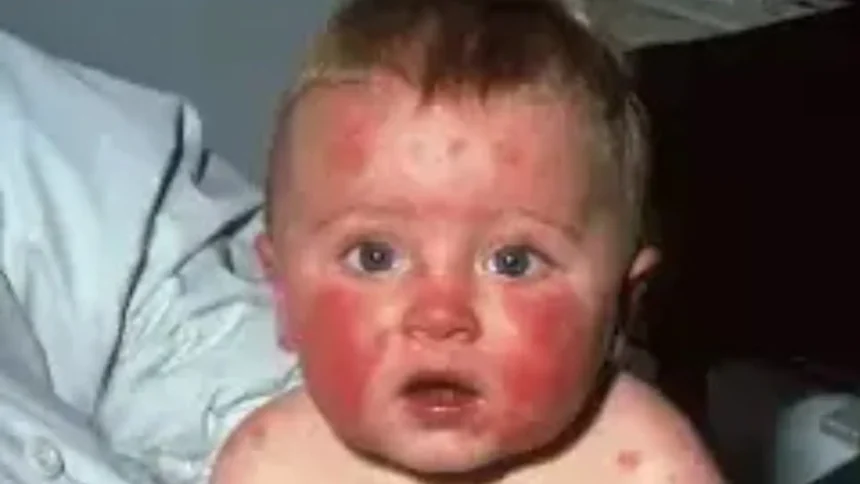Slapped Cheek Syndrome
Slapped Cheek Syndrome, also known as Fifth Disease, has recently gained attention due to a CDC warning about rising cases in the U.S. This contagious viral illness, caused by Human Parvovirus B19, is common in children but can also affect adults, particularly those with weakened immune systems and pregnant women.
The disease gets its name from the distinctive red rash that appears on the cheeks, giving the appearance of a “slapped face.” While it is usually mild in healthy individuals, it can pose serious risks for certain groups.
Why Is the CDC Warning About Slapped Cheek Syndrome?
The CDC has issued a warning following an increase in cases across schools and daycare centers in the U.S. The virus spreads quickly through respiratory droplets, making children in group settings more vulnerable to infection.
In most cases, Slapped Cheek Syndrome is not life-threatening and resolves on its own. However, certain individuals face greater health risks, including pregnant women, those with chronic blood disorders, and people with compromised immune systems.
This article will cover seven key facts about Slapped Cheek Syndrome, including symptoms, risks, prevention, and treatment options.
1. What Causes Slapped Cheek Syndrome?
Slapped Cheek Syndrome is caused by Human Parvovirus B19, a virus that targets red blood cells in the body. The infection primarily spreads through respiratory droplets, making it highly contagious in the early stages.
The virus can also be transmitted through:
| Mode of Transmission | Description |
|---|---|
| Direct Contact | Exposure to an infected person’s respiratory secretions (e.g., sneezing, coughing). |
| Contaminated Surfaces | Touching contaminated surfaces and then touching the face or mouth. |
| Blood Transfusions or Organ Transplants | Rare cases where the virus spreads through blood transfusions or organ transplants. |
Once a person develops the rash, they are no longer contagious, but they may have already unknowingly spread the virus.
2. How Does Slapped Cheek Syndrome Spread?
The contagious period of Slapped Cheek Syndrome occurs before symptoms appear. This makes it difficult to prevent transmission since people do not realize they are infected.
Modes of Transmission:
| Mode of Transmission | Description |
|---|---|
| Person-to-Person | The virus spreads through coughing and sneezing in close-contact settings like schools. |
| Surface Contact | The virus can linger on objects such as toys, doorknobs, and tabletops. |
| Blood Transmission | In rare cases, Parvovirus B19 can spread through blood products or maternal-fetal transmission during pregnancy. |
Once symptoms begin, especially the rash, the risk of transmission significantly decreases.
3. Recognizing the Symptoms of Slapped Cheek Syndrome
Slapped Cheek Syndrome presents with flu-like symptoms before the rash appears. Symptoms can vary depending on the person’s age and immune response.
Common Symptoms Include:
| Symptom | Description |
|---|---|
| Bright Red Rash on Cheeks | Hallmark sign of Slapped Cheek Syndrome, giving a “slapped” appearance. |
| Flu-like Symptoms | Fever, headache, sore throat, and fatigue. |
| Runny Nose and Mild Cough | Often mistaken for a common cold. |
| Joint Pain and Swelling | More common in adults and can resemble arthritis. |
| Lacy, Red Rash on Body | Appears after the cheek rash and may spread to the arms, legs, and torso. |
Symptoms in Adults vs. Children
| Group | Symptoms |
|---|---|
| Children | Typically experience mild symptoms, with the rash being the most noticeable sign. |
| Adults | More likely to develop joint pain and swelling, similar to arthritis, lasting several weeks. |
4. Who Is Most at Risk?
While Slapped Cheek Syndrome is mild in most cases, certain groups are at higher risk of complications.
High-Risk Groups Include:
| Risk Group | Impact |
|---|---|
| Pregnant Women | Parvovirus B19 can infect the fetus, increasing the risk of fetal anemia and miscarriage. |
| Pregnancy Complications | Most pregnant women recover without issues, but those infected before 20 weeks have a higher risk of complications. |
People with Weakened Immune Systems
| Risk Group | Impact |
|---|---|
| Individuals with Weakened Immune Systems | Those undergoing chemotherapy, organ transplants, or with HIV/AIDS may develop severe and prolonged infections. |
| Chronic Anemia Risk | The virus can cause chronic anemia, requiring medical intervention. |
| Individuals with Chronic Blood Disorders | People with sickle cell anemia or thalassemia are at risk for an aplastic crisis, where their body stops producing red blood cells, leading to severe anemia. |
When to Seek Medical Attention
If you or someone you know falls into one of these high-risk categories and develops symptoms of Slapped Cheek Syndrome, it is crucial to seek medical attention promptly.
5. How to Prevent Slapped Cheek Syndrome
There is no vaccine for Slapped Cheek Syndrome, so preventive measures are essential to reduce the spread of infection.
Best Prevention Strategies:
| Prevention Measure | Description |
|---|---|
| Frequent Handwashing | Wash hands frequently with soap and water to reduce the spread of the virus. |
| Avoid Close Contact | Avoid close contact with infected individuals, especially in high-risk groups. |
| Disinfect Surfaces | Regularly disinfect commonly touched surfaces in schools and daycare centers. |
| Proper Cough and Sneeze Etiquette | Encourage children to cover their mouth and nose when sneezing or coughing. |
| Precaution for Pregnant Women | Pregnant women should avoid exposure to individuals with suspected infections. |
Good hygiene practices can significantly reduce transmission rates, especially in environments where children interact closely.
6. Treatment and Recovery from Slapped Cheek Syndrome
There is no antiviral medication for Parvovirus B19. Most people recover with supportive care aimed at relieving symptoms.
Home Remedies for Symptom Relief:
| Treatment Method | Description |
|---|---|
| Rest and Hydration | Supports immune recovery and helps the body fight the virus. |
| Pain and Fever Management | Over-the-counter pain relievers like acetaminophen or ibuprofen can help reduce fever and joint pain. |
| Skin Care | Moisturizing creams can help relieve rash-related skin irritation. |
Most people recover within two weeks, but symptoms like joint pain may persist for several months in adults.
For individuals with severe anemia, medical interventions like blood transfusions may be necessary.
7. What Are the Long-Term Effects of Slapped Cheek Syndrome?
For most individuals, Slapped Cheek Syndrome does not cause long-term complications. However, in immunocompromised individuals and pregnant women, the virus can have serious health consequences.
Possible Complications:
| Complication | Description |
|---|---|
| Severe Anemia | High-risk groups may develop severe anemia requiring hospitalization. |
| Fetal Complications | Pregnant women risk miscarriage or hydrops fetalis, a life-threatening fetal condition. |
| Prolonged Joint Pain | Adults may experience long-lasting joint pain, resembling rheumatoid arthritis. |
If you experience lingering symptoms beyond the typical recovery period, consult a healthcare provider for evaluation.
Most read: https://tnheadlines24.com/deadly-mystery-disease-in-congo/
Final Thoughts: Stay Informed and Take Preventive Measures
The CDC’s warning about Slapped Cheek Syndrome highlights the importance of awareness and early prevention. While the illness is mild in most cases, pregnant women, immunocompromised individuals, and those with blood disorders should be especially cautious.
By following preventive strategies such as frequent handwashing, avoiding close contact, and seeking medical advice when necessary, you can protect yourself and your loved ones.
If you suspect you have been exposed or are experiencing symptoms, consult a healthcare professional for proper diagnosis and management.
Disclaimer: This article is for informational purposes only and should not be used as a substitute for professional medical advice, diagnosis, or treatment. Always consult a qualified healthcare provider for any medical concerns. TN HEADLINES24 is not responsible for any actions taken based on the information in this article. Readers should conduct their own research and seek medical guidance when necessary.




